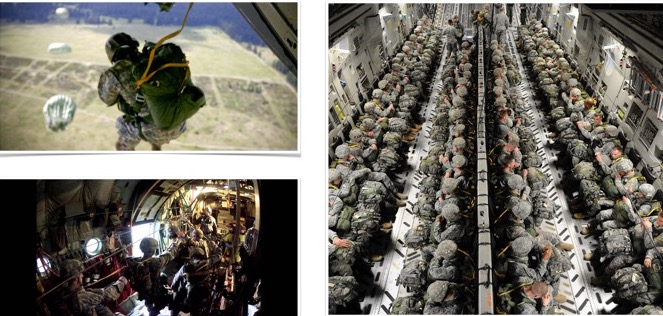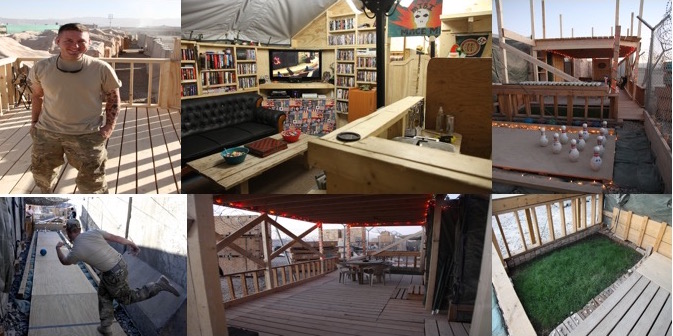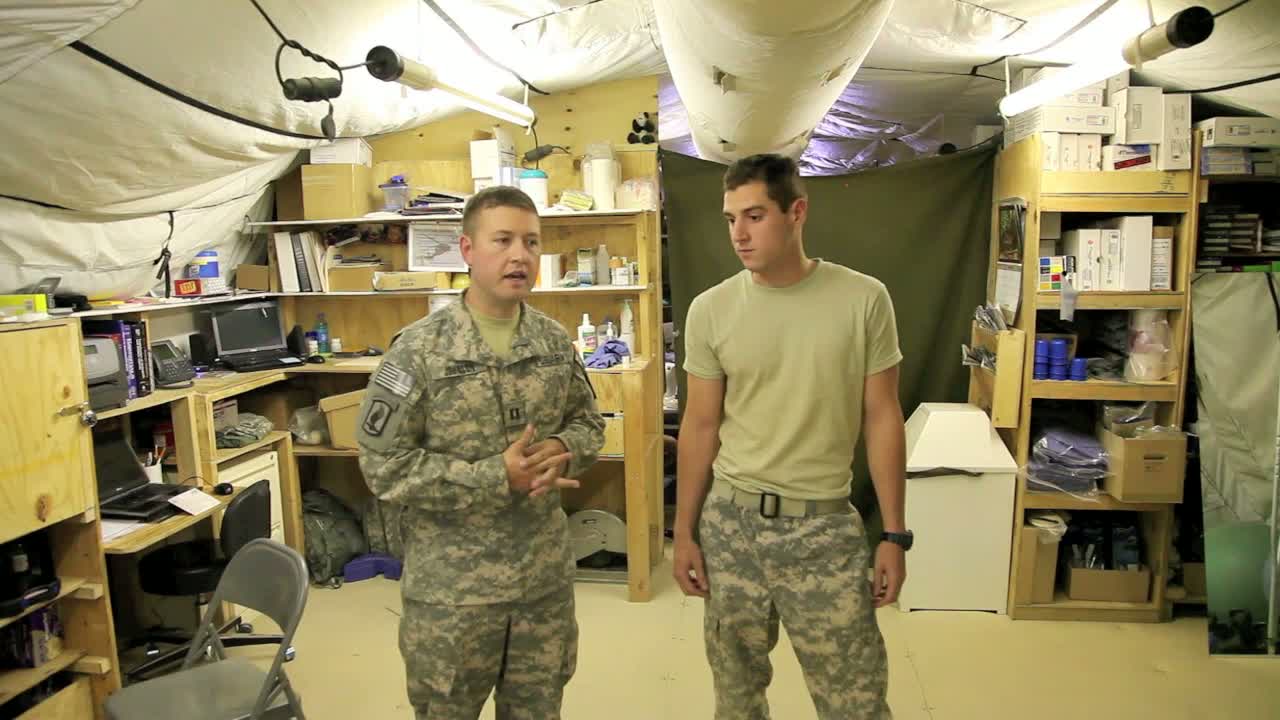Erik: Thank you so much. I am really excited to be here today. Today is probably one of the most important topics that we are going to talk about throughout the week. It is important to address the the mental health aspects of treating soldiers to get them to the next step. That is what I want to address today. Information and opinions expressed in this presentation are not intended or should not be taken as representing the policies or views of the Department of Defense, its component services, or the United States Government.
Introduction
The insane command of silence is no doubt one of the most powerful and potentially unsettling things that you can experience. This terrifying silence hit me in the face several years ago as I exited a C-130 for the first time with 63 other paratroopers.

Figure 1. C-130 paratroopers.
If you are not familiar with the C-130, it is basically a military plane that is designed to drop soldiers into combat from a very low altitude. There is a lot that is happening as you prepare to jump out of a plane for the first time. Over the first few weeks of your Airborne School training, you are constantly reminded of exactly what to do, at what time, in what place, and in what order. Our military vehicles are not really designed to be all that quiet, and it is very loud. The jumpmasters, who are in charge, want to keep your mind occupied so that you do not get in your head too much. When it is your time to jump, you start leaving the plane very quickly in a mass exodus. Your mind is racing, and they are yelling at you. Your heart is pounding, and people are saying, "Go, go, go!" All of a sudden, you are out into the day or night sky. There is so much that leads up to that point, and then you are floating and that noise disappears. During my first jump, my mind completely cleared and felt like so many things in my life came into focus. In that silence, I realized that I wanted to do great things. I am doing great things, and I want to continue to do that. It is no secret that most successful and effective leaders today purposefully shut themselves down daily to meditate in silence. There is so much power in that quiet. Our lives are very busy and we all live to get to that next anticipated moment. We expect something, we think it is going to happen, and we want it to happen. When we get there and it does not come to fruition, we automatically start to fill up with one of two things, either anxiety or solution. If you give yourselves a daily amount of time to meditate, you will begin to find those solutions in that silence. Try to find ways to eliminate the anxiety and fill things with solution. We cannot be effective clinicians or leaders without clear, objective, and personal problem-solving. I encourage you to do yourself a favor and take that time daily.
The Unseen Injuries
As I talk to you today, I want you to think about our history as it relates to current practice and treatment approaches. I have talked before in a previous session about the history of occupational therapy and as it relates to where we are at now. As you know, we started out in World War I as reconstruction aides. They would pull people off those front lines because of a combat stress, battle fatigue, or shell shock. We would try to normalize things and get them back to the fight. We will talk about the combat stress part of things later. But first, I want to go into the other unseen injury as it relates to what we have seen in these most recent wars in Iraq and Afghanistan, and that is mild traumatic brain injury.
Mild Traumatic Brain Injuries
Mild traumatic brain injuries, or mTBI, is such a interesting diagnosis because of the fact that concussions have been around for awhile. In recent wars, especially in Afghanistan, we realized that mTBIs are a huge problem. We needed to identify and treat clients with mTBI to keep them in the fight. We are all aware that our military is volunteer, and it serves to protect the United States from foreign wars. We need to help patients, both soldiers and civilians, be able to understand and identify these injuries.
Acute Injury
The biggest difference that we see now with injuries, in Afghanistan, Iraq, or in any current conflict, is that OTs are going to see these injuries a lot more acutely than maybe they would see in the traditional clinical setting. The reality is that these patients will have gotten a blast just maybe a couple hours ago, and then all of a sudden their symptoms are very in the now. I will talk about how we screen and treat these.
Mechanism of Injury
Another big difference is the mechanism of injury. Our injuries in the civilian world are more sports-related injuries like football and boxing. We would also see mTBIs from motor vehicle accidents or falls. In the military setting, it is very different. These are mostly due to a concussion blast wave that comes from a roadside bomb or an IED, an improvised explosive device. The concussive wave moves right through them including the brain. As a matter of fact, the military is looking at this particular injury as something different than a normal concussion and labeling it differently because of the mechanism of injury.
Clinical Practice Guidelines
The Army has Clinical Practice Guidelines which gives us a way to treat this type of injury. This is used on the front lines with a combat medic, in the theater (center of military operations), and all the way to a Level II facility. It is a treatment algorithm. If there is a blast at all, and you are within 50 meters of it, we are going to screen everybody, regardless of if there are symptoms or not. We want to be able to clear you to be able to go out. Additionally, if you are within that 50 meters, it is a mandatory 24-hour rest before you are able to go out. This is because those symptoms might pop up within that 24 hours.
Statistics
Statistics from the Department of Defense between 2000 and 2014 show that brain injury has increased. In the Army for example, we had about 3,000 diagnoses of mild traumatic brain injury. By 2006, this number was 7,000, 2009 was 15,000, and in 2010's 15,000 injuries. You can see the trend is that these numbers are increasing. One of the reasons may be that we started to identify these concussion injuries as a huge problem. And perhaps, some of the symptoms that we are seeing are not necessarily aligned with a mental health injury but with a brain injury from a blast. We are also able to identify this better and better as we progress in war. It is no secret that with a war, we are able to advance medicine. The war in Afghanistan brought a huge amount of attention to mild traumatic brain injuries or concussions. That term can be used interchangeably. Another shocking statistic is that at the end of 2013, there were 237,000 concussion injuries that were labeled through the armed forces. These were not all blast injuries, but it was in total. However, I can tell you that the majority were from the concussive blasts while soldiers were out on combat patrols.
The Evaluation Process
We have five echelons of treatment. I am going to go over the first two levels which are in "theater", or military operation area.
Level I Treatment
Level I treatment are your First Line Medics. These are guys out of high school and went through their advanced individual training to be a combat medic. Our combat medics go out on a patrol with guys. If an injury happens, they are the first responders. Their goal is to save lives immediately and then move them to the next echelon of care. The medics do an initial MACE evaluation, which is the Military Acute Concussion Evaluation. This is a matrix taken from different samples of peer-reviewed, standardized tests from the civilian world. It was put together to make it more applicable to a military service member. It includes a cranial nerve screen, memory testing, and looking at symptoms. If there are any red flags in the initial screen, they would evacuate the soldier to a Level II facility where the Concussion Care Centers are located.
Medevac to Level II
Once we get to Level II, this is when the OT would come into play. I was the first OT to deploy with a brigade combat team as a TBI therapist. An OT does not do the evaluation. We are part of a team with a physician assistant, a medical doctor, a nurse practitioner, or the like. They are the ones that have a license to actually diagnose it. However, we will do the full neuro screening with the team. The service member(s) come in for an evaluation. Usually, several of them come in at the same time as they may be involved in the same incident. We do a full screen of anyone within a 50-meter radius. We are also going to do a full evaluation for physical injuries. We are going to determine if the soldier is right for the concussion care program. Again, we are going to look for the red flags and any comorbidities as it relates to behavioral health. This is where the unseen injury is to really come into play.
Things you want to look for are unequal pupils, repeated vomiting, and worsening headaches. Are they disoriented? Do they have any vision impairment, like double vision? Are there any seizures? Any weakness? We are also doing a cranial nerve screen. We also want to know if there was a loss of consciousness. This has to be witnessed because if the soldier is telling us one thing, and something else happens, we are not really sure how to approach it. Are there abnormal speech patterns? Is there any kind of irritability or unusual/combative behavior? The patients will often complain of minor headaches or other symptoms. If there is nothing else going on, we are going to have them rest for about 24 hours. If they are still asymptomatic, they are going back out.
This leads us to the Concussion Care Center. I spent the whole time that I was in Afghanistan building up this program (see Figure 2).

Figure 2. Concussion Care Center.
I designed it very specifically with different treatment areas to address different symptoms. For example, we built a back deck with stairs so that they could work on climbing stairs and work on vertigo-type issues. The initial rules of the program include:
- No TV
- No Video Games
- Minimal Internet
- To check e-mail/contact family
- Limit Reading
- Daily expectations including clinic maintenance.
- Rest, rest, rest
My goal for the initial 24 to 48 hours was to have them shut down and reboot. I took all this from the University of Florida's concussion program, where several years ago Tim Tebow got treated for a concussion. They told him to turn his brain off so that it could rest. I used this same protocol. For that first 24 to 48 hours, I did not want them to do anything. I did let them have minimal internet because I wanted them to be able to check their email and communicate with their loved ones. If you are in combat and you are injured, the Red Cross will contact your family and let them know that there was an injury, and if there is a death, they will come to the home of the family. However, they do not give a lot of details when they make the call to the family. I let the service member contact their family to ease their worries. However, I am going to minimize it as much as possible. I also limit reading. The daily expectations are clinical maintenance. I want them to rest, but I also want them to engage in life as they would normally. A lot of intervention involves education. I explain that their brain needs to heal just like any other physical injury. I am not going to push too hard. They come to the Concussion Care Center that has video games, DVDs, and other activities. I do not let them engage in these activities right off the bat. As we start to engage them in treatment, we will start to introduce some of these. I also need to decide if it is a good idea to let them participate in video games like Halo or Call of Duty as they were just living this in person.
The average length of stay was about 72 hours in the Concussion Care Center. During this time we get the service member more involved in their daily routines. The expectation is that they will wake up in the morning and begin to engage in normal routines and roles. I want to see if any of these symptoms start to pop up. Are there still some things that I'm worried about? Do they still have that photophobia? Are they getting dizzy as they work? I am also going to let them have a little bit more freedom. Then, I am going to start engaging them in different types of treatment specific to brain injury, like the FORCE mTBI. FORCE stands for the Functional Oriented Rehab for Combat Injuries.
There are a lot of people involved on the team. The Level II Team Includes:
- OTR/L
- 68L COTA (NCO)
- 68W (combat medic)
- RN
- Physical Therapist
- PA
- MD
- CRNA
- Psychologist (Combat Stress Team)
We have the certified OT assistant, a combat medic, which is the 68 Whiskey, a nurse, physical therapist, PA, MD, CRNA, and behavioral health team. Next we are going to do a case study. I am also going to show you a video here in a minute.
Case Study 1
I want to introduce you to Sgt. Pereira now. He was one of our TBI patients. Now, Sgt. Pereira, why do not you tell everybody a little bit about what happened and what brought your to the TBI clinic?
Video 1

A couple things that I want to point out is that you see in there is they are actually engaged in a fire fight. In that particular moment, there was no physical injury that you could see. However, this shows what a concussive force can do. The blast wave came through that wall and hit him. This is a perfect example of an unseen injury. You can tell right away that something has happened. He is dizzy, nauseous, and has photophobia. All of these things happen right away.
